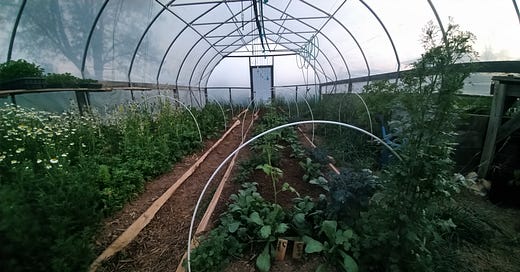IN light, my soul is yearning flight to take;
in light that makes the world to rise and swell.
therefore, my angel, stand thou forth!
with resolution right and true,
imparting thought with might anew,
sustain me through these swells of ecstasy
which would swallow me in the senses’ tapestry.
Liturgy of the Year, Week 7, translation by
Greetings and happy May festivities to you all!
Things have certainly been busy this month and for most of us here in the Northern Hemisphere our gardens and farms are starting to transform as we approach the beginning of Summer.
In this Journal, we will be exploring the celestial conditions for the last half of May and we’ll be following the Moon in its movement through the Sidereal Zodiac, the way the stars and other celestial bodies appear to us in the present moment. Using this cosmic guidance, we can alter our own daily choices when working with plants, creating a more harmonious environment for everything in existence. Times here are given in Eastern Standard Time and we encourage you to experiment with these calendar recommendations in order to meet the unique needs of your garden and regional climate conditions.
Turning to our calendars, we see that on Saturday, May 11th, the Moon reached its highest point in the sky at 4am and now for the next two weeks the Moon will be descending relative to the Southern horizon - cycling through half of the Zodiac. This downward influence (in relation to Earth) presents us with good conditions for transplanting, root growth and soil cultivation since life energies are descending (being held within the soil and roots) rather than ascending into plants’ branches, flowers and fruits.
As the Moon descends today, Monday, May 13th, it also enters into the Water sign of Cancer at 2am encouraging us to care for leafy plants. As we transplant lettuce, spinach and other greens this morning, we can meditate on the ether of tone, bringing our awareness and gratitude to our relationship with each seedling and continuous flow of life that we have the opportunity to participate in as farmers.
Early in the morning on Tuesday, May 14th the Sun transitions into the Earth sign of Taurus as the Moon continues to shine on us backed by the constellation of Cancer. Continue your work with leafy crops throughout the day until the early evening when the Moon then moves into Leo.
For the next two days, Wednesday, May 15th and Thursday, May 16th the Moon remains in the Fire sign of Leo. Spend time caring for fruiting plants and bring awareness to the ether of Warmth. Plant tomato, squash, beans and other fruiting plants today as we soak up the increasing abundance of yellow Sun light that rains down upon us giving life to our gardens.
On Friday, May 17th, continue to work with fruiting plants until the early evening when the Moon then moves into the Earth sign of Virgo. At 3pm the Moon reaches its farthest point away from the Earth in its cycle, called Apogee, which in general does not have a negative effect on plant growth. Transplant, care for root crops and work with the soil as needed through the day.
All this weekend, Saturday, May 18th, Sunday, May 19th and Monday, May 20th the Moon remains in the constellation of Virgo making this a great opportunity to transplant out seedlings and cultivate the soil. As usual, the evening before doing soil work is the recommended time to offer BD 500 Horn Manure, the Pfeiffer Field Spray or Barrel Compost to our farms and gardens with the intention of supporting a healthy abundance of soil life. To learn more about these Biodynamic preparations please check out our other articles here on Substack as well as the resources available at JPIBiodynamics.org
On Sunday the 19th, the Moon crosses through the Sun’s ecliptic and we might refrain from work for a few hours in the midday to allow the effects of this occurrence to subside.
For those following esoteric Christianity, Sunday is celebrated as Pentecost, the 50th day after Easter, marking the descent of the Holy Spirit onto Mary and the Apostles. As described in Living a Spiritual Year by Adrian Anderson:
“Pentecost can (then) be considered to be a festival of flowers… flowers are the result of the plant’s striving up to the light, as well as the descent of the rays of warm sunlight to the plant, so too the ‘fiery flames’ of the spirit which descended onto the disciples may be thought of as the response of the spiritual sun to the striving toward spirituality by the disciples” (pg 303)
Anderson continues to explain the significance of today and the seasonal sequence which occurs each Spring:
“First, through the mystery of Golgatha. The continued healthy existence of the (physical) earth itself was assured… through the springtime Easter sacrifice the physical body of humankind is imbued with the solar life ether… Then in the Ascension event historically, and seasonally (each year), the ethereal forces of the earth and humanity are protected from luciferic influences. Finally, in the Pentecost event the soul (that is, astral forces) of the individual who seek consciously to attain the spirit self can be permeated by the holy spirit” (pg 304)
If we choose to, we can bring this awareness into our work this weekend as we continue to build relationships with the Mineral, Plant and Animal kingdoms as well as our own inner Selves. There is much more to explore in regards to these seasonal festivals and we highly recommend checking out the Rudolf Steiner Archive, the contemporary writings of JPI Creative Director Stewart Lundy and many others to continue to learn more and to find ways to incorporate these lessons into your own life.
On Tuesday, May 21st the Moon remains in Virgo until 1pm when it then moves into the Air sign of Libra. This afternoon and tomorrow, Wednesday, May 22nd spend time tending to your flowering plants while paying attention to ether of Light. In regards to Pentecost, we can celebrate the marriage of beauty that exists within each flower found within our gardens, a tangible result of both ascending and descending life forces.
Wednesday morning, with the Moon in Libra, would also be a good time to offer BD 501 Horn Silica to support plant health, photosynthesis and to aid in the formation of quality crops.
We might also add BD 508 Equisetum tea and/or BD 507 Valerian to any of our stirs this week to help bring balance and harmony to our gardens. More information about these two specific preps and their extended uses is available on the Josephine Porter Institute for Applied Biodynamics website.
At 12am on Thursday, May 23rd the Moon transitions into the Water sign of Scorpio where it will remain in until Saturday. For the next 2 days, Thursday and Friday, May 24th focus care on leafy vegetables. Bring awareness to the feeling of your gardens as the season progresses and give thanks to clean water which is essential to our lives.
On Saturday, May 25th at 9am, the Moon moves into the constellation of Saggitatius which has an affinity to Fire. Throughout the day as well as tomorrow, Sunday, May 26th tend to fruiting plants. As we work this weekend, pour your Love into the soil giving thanks to the abundance of life that exists all around.
At 4pm on Saturday, the Moon reaches its lowest point in the sky, marking the end of Biodynamic Transplanting Time. From Sunday until June 7th, the Moon will now be ascending, influencing life forces to rise, making it an ideal time to seed, harvest and collect aerial plant parts (specifically flowers which will later be used to make our BD Preps).
Thank you all for tuning into our bi-monthly journal! We encourage you to adapt and incorporate any or all of this into your own work with plants. To learn more and to follow along, check out the Stella Natura Biodynamic Calendar and Maria Thun 2024 Biodynamic Almanac , both currently in stock at JPIBiodynamics.org
Wishing you all the best - Russell










What a gorgeous, gorgeous tunnel!
I dream of being able and sufficiently organized to do all of this.
In the meantime, our 1/4 acre "farm" is a whack-a-mole game extraordinaire. Right now it is skunks.
On the plus side: they eat many of what we "battle" - slugs for sure and grubs (Bt inoculation now 20+ years old) and they are probably a great deterrent to night-time mischief =;-)
But on the negative side: the 3' high beds we built, screened for birds and "easily" topped with plastic for unexpected frosts - well, apparently (and I looked it up) - skunks can JUMP! Yup - lots of digging going on. And they (inadvertently I'm sure) tramples the un-trellised peas (in the bed, mainly or nitrogen fixation but certainly for peas also!))
Between the (now skunks), chipmunks (all pots are "mulched" with mugho pine cones - works), squirrels and birds (nylon "socks" work for large tomatoes and round tree fruits) - seriously, it's the whack-a-mole thing. New this year are the cattle panel "tunnels" - for roaming things like squash and melons we haven't room for otherwise). SIgh.
It is hard to keep one step ahead of the critters. And I'm not into killing things. OR "removing" them which in most cases is just more torturous death.
Have you some thoughts on this or blog post? With bigger plots maybe it is less percentage damage. We have delightful birds - no complaint there (year round water with heat tape in winter). I'd like to co-exist with these critters who need to eat too. We are pretty much the only Feeding Place in a good distance of suburban "round-upped" pristine lawns and landscaping (not gardens).
Sorry so long a post, but you are an expert in All Things Biodynamic, so hoping you'll have some wisdom to share =:-))
Many thanks ❤️